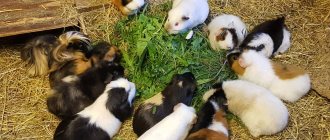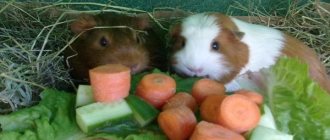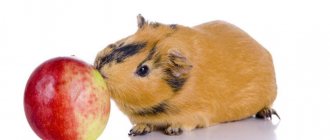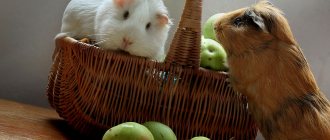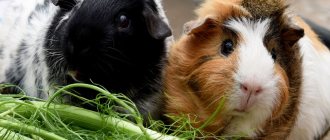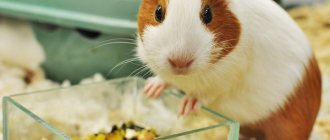What is the best food for guinea pigs?
Feeding your guinea pig correctly
| Category | Place | Name |
| The best standard foods for guinea pigs | 1 | Vitakraft Menu Vital |
| 2 | Prestige Versele-Laga Crispy Muesli Guinea Pigs | |
| 3 | JR Farm Classic for guinea pigs | |
| 4 | Fiory Indy for guinea pigs and chinchillas |
Greens and vegetables
Each animal owner independently decides which products from the 4 remaining diets will be the main ones in the daily menu, and which ones will be additional. In this case, it is necessary to take into account the health characteristics of a particular animal. Therefore, it is better to decide on the composition of an individual diet for an animal together with a doctor.
What plants are allowed to be given to a guinea pig?
Guinea pigs are vegetarians. Of course, the animals do not refuse granulated food. This is a convenient, but not the most healthy option for feeding rodents. Natural food is much healthier for animal health.
Many owners of furry pets doubt whether parsley can be given to guinea pigs. This beneficial herb should be present in the diet whenever possible every day. However, given the diuretic properties of the plant, its amount should be limited for pregnant female rodents.
Some owners grow dill and other permitted greens on the windowsill for guinea pigs.
Table 1. Greens that are allowed for guinea pigs
| Name | Features of the composition | Effect on rodents |
| Parsley | Lots of B vitamins, vitamins K, C. | Improves intestinal motility, strengthens the immune system, and reduces stress levels. |
| Dill | Ascorbic acid (132% of the norm per 100 g of product), beta-carotene, folic acid, alpha-tocopherol, vitamins. | Improves appetite, optimizes digestion, increases lactation in lactating females. |
| Cilantro | Vitamins: E, C, B, D. | Stimulates increased appetite, calms the nervous system, and helps strengthen bone tissue. |
| woodlouse | In addition to vitamins and rare microelements, it contains many beneficial essential oils. | Strengthens the immunity of rodents, accelerates intestinal motility. |
| Spinach (leaves) | Lots of iron, calcite, healthy proteins, potassium, phosphorus. | Improves digestion, supports the functioning of the cardiovascular system, strengthens bones. |
| Lettuce (leaves) | Contains potassium, calcium, iron, folic acid, and a high percentage of sucrose. | Normalizes metabolism and digestion, maintains muscle tone. |
| Alfalfa | Lots of proteins, calcium. | Promotes the full development of the musculoskeletal system. It is given fresh without restrictions. Dried alfalfa is given occasionally, in small quantities. |
Important! 100 g of fresh spinach leaves contains over 700 mg of potassium. The plant is extremely useful for strengthening the heart muscle of animals.
The genitourinary system of rodents works in a state of tension most of the day. To strengthen it, you should add yarrow to the pigs' food. The plant has a beneficial effect on the functional activity of the animals' kidneys and significantly improves appetite.
To reduce your guinea pig's blood pressure levels, add fresh or dried nettle to its diet. Due to the diuretic properties of the plant, the animal's urine output slightly increases.
It's no secret that the Achilles heel of guinea pigs is digestion. To help the animals’ digestive system, experienced breeders treat their animals with pink clover from time to time. It is important not to overdo it, because young plants contain a significant amount of cyanogenic glycosides.
If there is too much clover in a guinea pig's diet, it can cause diarrhea.
What grass do guinea pigs not eat?
The fragile organism of a small rodent does not care at all what kind of grass is given to it. The animal’s digestive system reacts to some plants with diarrhea or vomiting. Herbs that contain substances that are poisonous to animals should not be included in the diet.
Table 2. Plants harmful to guinea pigs.
| Name | Effect on rodents |
| Avran | Nausea, diarrhea, intoxication. |
| Hemlock | Contains alkaloids that cause poisoning. The animals' paws go numb, their temperature drops, their heart rate increases, and convulsions begin. |
| Ranunculaceae | Increased salivation, shortness of breath, decreased temperature, development of diarrhea. Attacks of hyperactivity. |
| Datura | Paralysis of the heart and limbs. |
| cornflower | Vomiting, colic, diarrhea, paralysis. |
| Spurge | Inflammation of the gastrointestinal tract, vomiting, diarrhea, cramps. |
| Celandine | Diarrhea, flatulence, general weakness, nausea. |
Important! Garlic and onions contain a lot of phytoncides and have a painful effect on the delicate lining of the pig’s stomach. These plants should be excluded from the rodent menu.
Rules for collecting and processing herbs
For the health of guinea pigs, it is extremely important to use plant materials that were harvested in environmentally friendly areas.
It is prohibited to collect grass for animals where there is:
- industrial facilities;
- busy roads;
- garbage bins;
- dog walking areas;
- waste dumps.
Near fields and vegetable gardens there is a danger of harvesting grass with nitrates and pesticides. It is better to collect plants in open meadows, away from pollution zones.
Important! Freshly washed greens can be offered to animals that are accustomed to eating wet grass. But experts recommend pre-drying washed plants so as not to provoke gastrointestinal disorders in domestic rodents.
Greens that were collected from environmentally friendly areas are not washed. But if there is dust or dirt on the grass, rinse it in warm running water. For winter use, the plants are finely chopped and frozen in plastic bags.
Important! Dry herbs should not be treated with boiling water. High temperature kills microbes, but also greatly reduces the amount of vitamins.
Vegetables
These foods are incredibly important for your guinea pig's health. They are a daily part of the diet of adorable rodents. Zoologists say that animals that are deprived of the required amount of vegetables get sick more often and live shorter lives.
Table 3. Vegetables for guinea pigs.
| Allowed | Prohibited |
| Zucchini, Jerusalem artichoke, ripe eggplant, cucumber, white cabbage, bell pepper, carrots, pumpkin, peas (fresh), rutabaga, beets, turnips. | Potatoes, radishes, radishes, corn kernels, Chinese cabbage. |
Any of the permitted types of vegetables should be given to your pet in small pieces first. If the pig likes the food, next time the amount of product is gradually increased.
Basic rules for feeding rodents vegetables:
- Give foods raw.
- Pre-wash the fruits, scald with boiling water, cut off the hard skin.
- Do not exceed the average daily weight norm (70–80 g, depending on the weight of the animal).
Can guinea pigs have zucchini?
Guinea pigs can be given not only the vegetable itself, but also its leaves - they are very useful for small rodents. Juicy zucchini contains a lot of water with a modified structure. This liquid is extremely beneficial for the digestive system of rodents.
Young guinea pig squash does not need to be peeled; their skin is so delicate that it will not harm the rodent’s stomach.
Cucumber
These vegetables are allowed to be fed to rodents along with seeds. If cucumbers are grown in your own garden, you can give them to guinea pigs along with the skin (not too thick).
Experts recommend including 1 small cucumber in the animals’ diet every day. This vegetable is absolutely safe for animal health, has a neutral taste and is more than 90% liquid.
Important! Salted or pickled cucumbers are prohibited from being included in rodent menus.
Tomato
This vegetable is allowed to be added to rodent food, but in limited quantities. There are animals whose digestive system does not accept this product at all. A lot depends on the individual characteristics of the rodent’s gastrointestinal tract.
If you want to give your guinea pig a tomato, it is important to remember that:
- all green tails of the vegetable must be removed;
- the tomato must be absolutely ripe;
- tomato leaves and stems should not be in the diet of pigs, they are poisonous to animals;
- You can feed your pet tomatoes 3-4 times a week - the animal receives no more than one slice (or 1 cherry tomato) at a time.
You should not get carried away with nightshade plants in the diet of guinea pigs. Unripe vegetables of this family contain substances toxic to rodents.
Is it possible to give guinea pigs cabbage: Chinese cabbage, white cabbage?
When choosing a product for a guinea pig menu, you should give preference to white or red cabbage. These vegetables are a source of fiber, beneficial minerals, vitamins (especially C), and can be given to pigs daily. Cabbage is necessary for animals for physical activity and strong immunity. In addition, the product contains a lot of antioxidants, beneficial amino acids, and beta-carotene.
Most guinea pigs love to crunch on a fresh cabbage leaf. However, you should pay attention to the fiber density of the plant. The pieces of young cabbage in the rodent feeder can be made larger. But if the leaves are harsh, they must be finely chopped before offering them to rodents.
Experts do not recommend giving Chinese cabbage to guinea pigs.
Beet
Experts believe that beets can be given to guinea pigs either raw or boiled. The tails are not removed from the fruit; the peel is not allowed to be peeled.
It is best to pamper animals with juicy beets during the cold season, when the availability of other vegetables is limited. Before use, the root vegetable is thoroughly washed and divided into pieces. Depending on the weight of the rodent, it can be given 50–80 g of product per day. Experienced breeders include beets in the evening feeding of their furry pets.
Important! For guinea pigs, it is better to choose beets that were grown on your own plot, without the use of chemicals. It is also allowed to use farm products.
Bulgarian pepper
You can give bell pepper to guinea pigs, but little by little and not too often. The vegetable contains a large amount of ascorbic acid, carotene, and vitamin C. 20–30 g of product per day is enough for one animal.
Before offering a juicy vegetable to a pig, remove the skin and remove the seeds. Even if the pepper looks clean and beautiful, but was purchased at a chain store, the product must be thoroughly washed.
If pepper is regularly included in the animals’ diet, the pet’s circulatory system will receive a reliable source of support. The substances contained in this juicy product actively strengthen the walls of blood vessels.
Experts advise feeding guinea pigs bell peppers during the seasonal fruiting of this vegetable. This will bring maximum benefits to the health of your furry charges.
Important! Hot and green peppers are prohibited for use in the diet of domestic rodents.
Can guinea pigs eat grape branches?
Without a doubt you can
give leaves and
twigs
of willow, spruce, maple, ash, poplar.
Shrubs - hazel (hazel), juniper, hawthorn, currant, raspberry. Banana leaves, pumpkin leaves, sunflower leaves, grape
, outer leaves of corn, and cauliflower leaves are also safe.
Interesting materials:
How to set your own background in Viber? How to set a timer on Rostelecom? How to put emphasis in Word 2022? How to charge the Vape? How to put a video on Windows 7 PC wallpaper? How to put a video on your Facebook profile? How to install a volcano? How to set high quality on YouTube? How to put a root sign? How to put an accent mark in Word?
Fruits
The main criteria when choosing fruit treats for pigs are:
- As little sugar as possible.
- A decisive “no” to sour foods.
- Use only ripe and fresh fruits.
Before giving fruit to animals, they are washed, scalded with boiling water, cut into small pieces, and the seeds are removed. It is advisable not to determine the amount of treats by eye; it is better to consult with a veterinarian about how much fruit you can give to a particular animal.
Table 4. How often can fruit be added to the rodent menu.
| 4–5 times a week | 1–2 times a week | 1 time per month |
| Apple, pear. | Banana, persimmon, orange, tangerine. | Pineapple, mango, kiwi, grapes, guava. |
Important! It is forbidden to give lemon to guinea pigs.
Fruits are a healthy part of a guinea pig's diet. These products diversify the diet and compensate for the lack of essential minerals and amino acids. However, moderation in the amount of treats should be observed. This is necessary to protect pigs from the development of allergic reactions and gastrointestinal disorders.
Important! Under no circumstances should guinea pigs be given citrus fruit zest or banana peels.
Healthy Supplements
The most common dietary supplement is vitamin C, which is diluted in drinks. It is not produced in the body on its own, but if the basic feeding rules are followed, guinea pigs receive it in sufficient quantities from fresh vegetables and feed mixtures. Vitamin C can be used as a supplement only as prescribed by a ratologist; usually such a need arises if we are talking about a weakened stomach or a prolonged period of artificial feeding.
Table of allowed vegetables, herbs, herbs, fruits, berries
Adult pigs require from 10 to 20 mg of vitamin C per day. The need for vitamin C may depend on seasonal fluctuations, under normal conditions, pigs kept in an apartment require from 10 to 15 mg, pregnant females about 20 mg. You can see how much your pigs actually get of this vitamin in the table. Keep in mind that products lose some of their vitamins during long-term storage in winter; vitamin C in them is reduced by an average of 1/3. All data in the table are average values, since the availability of nutrients is influenced by many factors, for example, storage conditions, types of varieties (different types of carrots, different varieties of apples), seasonality, etc. If you give fresh foods, then you shouldn’t give additional vitamin C, because it can only do harm. When there is an excess of vitamin C, the urine becomes acidic and a predisposition to kidney damage and skin irritation develops.
The calcium/phosphorus balance should be 1.5:1. For clarity, these data are shown in the table. In animals with kidney problems, too much calcium in the diet can lead to kidney and bladder stones.
Information
Unfortunately, it is not possible to find out the composition of all crops and indicate it in the list, so for some there is a dash.
Note:
As a rule, you can hear that cucumbers should not be given, because... contain a lot of water and little nutritional value. You can give cucumbers, but in moderation. In addition, one may hear that fresh food is rich in carcinogens and contains many chemicals, as a rule, such remarks are the result of false panic and are quickly spread in the media. In fact, all “harmful” substances are found in fresh foods, usually in very small quantities and do not pose any harm to health. If you see danger in everything, then the animals will simply have nothing to eat. For example, dill, which is now considered very healthy, has been considered dangerous for several years because it contains small amounts of safrole. The proportion of safrole in fennel is so low that it is not even significant for medical reasons. Carcinogenic safrole is effective only in large quantities (for example, in nutmeg, safrole from which is used as a medicine).
Information about substances:
Tannins: tannins include tannin. Its content, especially in the branches of old trees, can reach 20%. Tannin is used both in medicine and for processing leather products. Once in the pig's stomach, tannin is converted into gallic acid. And she, in turn, turns into pyrogallol, which is a poison. In experiments on animals there was an indicative result: pyrogallol changes cells at the DNA level. Hydrocyanic acid: unfortunately, it is still widely believed that tree branches with stone fruits (such as apricots, cherries, plums, etc.) contain hydrocyanic acid. This is not true! They do not contain hydrocyanic acid or amygdalin, which breaks down into hydrocyanic acid and fructose when reacting with water. Amygdalin is a constituent substance in the seeds of fruits, but not in the bark and leaves.
Making a diet for a guinea pig: This question tops the list of tasks that we mentally form when carefully carrying home a funny pet from the pet store. What do guinea pigs eat? Offhand, each of us will say that this must be some kind of grass and grains, perhaps bread. Yes, I remember the seller talked about hay, recommended some kind of food... What kind of food do rodents like? How much grain can they be given per day? What products are included in the ideal menu for rodents of the pig family?
[Hide]
Feeding recommendations
The pet needs to be fed correctly so that its health remains normal, its teeth are strong, and its coat looks well-groomed. Your pet's daily menu should include:
- 50% hay;
- 20% dry food;
- 20% juicy food;
- 10% greens.
An important question for owners is how many times a day to give food to a guinea pig. Feeding is carried out 3 times a day. The feeder cannot be removed from the cage; food must always be available to the animal. There should also always be hay in the cage.
If there is no dry food in the animal’s diet, then it must be replaced with a similar weight of greens and raw vegetables. The menu should be varied; the rodent must be offered at least three different vegetables per day and certainly grass. It is prohibited to give your pet grass collected on the sides of highways and in industrial areas.
The optimal menu is vegetables and fruits before noon, dry food after noon.
Are apples acceptable in the diet?
For these animals, apples are a delicacy along with pears and cucumbers. The type of apples doesn't really matter. But you should try to take into account at least the amount of sugars contained in the fruit. A lot of sweets in the diet is harmful for both people and guinea pigs. Apples are best given to your pig in the evening along with other types of food. This method contributes to the better appearance of the animal.
If we talk about the preferences of guinea pigs, then the animals themselves prefer sweet varieties of apples. If the apples are dried, then before serving it is recommended to soak them in water for 3 hours before treating your pet. Spoiled and rotten fruits should not be given to the pig. In addition to the fruits of the apple tree, as well as the branches, they are suitable for food consumption. The fruits can be fed both dry and raw.
The fruits contain useful substances such as:
- fiber with fructose;
- pectin;
- vitamins of group B and other important structures;
- a number of useful minerals.
Many owners cut apples before serving, but the best way to serve them is to serve them whole.
If the owner decides to cut the apples, it is important to remove all the seeds. They contain acid, which, when dissolved in the stomach, can become dangerous for a pet.
According to recent studies, the poison of even one berry is enough to kill a pet.
The available dietary fiber helps in overall cleansing of the body. Despite the fact that apples should be included in the regular diet, if you take into account the answers from experienced breeders, the benefits of fruits can be increased significantly:
- The apple fruit must be washed thoroughly and cut into small pieces;
- make sure there is no mold on the fruit;
- leave the seeds;
- the fruit should be moderately ripe, but not too juicy. Fibers that are too soft do not have the best effect on the condition of the animal’s incisors and muzzle. If the muzzle is very dirty, such an environment can become ideal for the growth of bacteria;
- It is not recommended to give sour fruits. The acids contained in the fruit can negatively affect the functioning of the gastrointestinal tract.
It is forbidden to give pieces of compote. The mass will turn sour in the stomach, it will not be digested, resulting in poisoning. Experienced breeders advise giving apples to your pet in the first half of the day. Unlike hamsters, animals eat less often at night and fiber may be less absorbed.
One serving should contain no more than 3 apple slices; it is advisable to treat your pig with a treat no more than 2 times a week. Due to the large amount of sugars, apples can cause obesity in large quantities.
Cucumber
A ripe cucumber is a source of water, potassium and vitamin C. Your pet likes the taste of a juicy natural product. Fresh fruit will quench thirst and normalize the process of assimilation by the rodent’s body of useful substances supplied with other food products.
It is better to give cucumbers to guinea pigs from your own garden.
During the season, the guinea pigs are given cucumbers grown in their own garden. A purchased harvest from a greenhouse may contain nitrates, which even in small doses can cause severe poisoning in an animal, resulting in death.
You can give cucumber to guinea pigs only in moderate quantities: a single serving is equal to a quarter of a medium-sized fruit.
Abuse of green vegetables provokes digestive problems.
How to give sweet peppers correctly
Feeding your guinea pig sweet peppers is easy. It does not require special processing or time-consuming preparations. A greenhouse product is unlikely to bring the desired benefits, so it should be given only during the season. During the period when pepper does not grow in the beds, it is recommended to replace it with a special balanced food containing all the vitamins and microelements in the required quantities.
In addition, you can consult a veterinarian regarding the advisability of taking vitamin C tablets, describing to him in as much detail as possible everything that your animal eats.
How to prepare a vegetable for feeding
Naturally, the pepper should be thoroughly washed before feeding it to the guinea pig. The washed vegetable is cleared of seeds and cut into small slices. It is also better to remove the thin film. Many pet owners often neglect this advice, but veterinarians strongly recommend giving bell peppers without the peel, since it is difficult to chew and can result in intestinal blockage.
Important! Green peppers contain solanine, which is dangerous for domesticated pigs. Animals should avoid eating this vegetable; they should also not be given hot peppers - this can harm their health.
How often and in what quantity can you give
Guinea pigs love fresh herbs and vegetables, including bell peppers. And, as a rule, as much as you put in their cage, they will eat as much. However, such overeating can cause serious harm to the health of this cute rodent. Therefore, treats should be given in doses. Bell pepper (100 g) contains 110 mg of ascorbic acid. Considering that other foods consumed by animals also contain vitamin C, but in smaller quantities, and the daily intake for a healthy animal should not exceed 16 milligrams per kilogram of weight, it is recommended to give no more than 25–30 g of pepper per day.
You should know about this
What could this moment be like? Eating unusual foods can cause the following disruptions in the body:
- allergy;
- problems with the urinary system;
- digestive disorders;
- poisoning
In the event of an allergic reaction, the animal's eyes may become inflamed, nasal discharge may appear, itching, loss of fur may occur, breathing becomes difficult, and the animal becomes apathetic.
Food with a high fat content makes the urine of rodents more alkaline, and this ultimately leads to damage to the kidneys and bladder, and secondary infections.
The reaction of the gastrointestinal tract may be loss of appetite, bloating, diarrhea; The vital activity of the pig decreases.
Well, some cheese ingredients are quite capable of causing acute poisoning with convulsions, vomiting, and excessive salivation. Refusal to eat may occur.
On the list of prohibited foods for guinea pigs, cheese is one of the first items along with sausage and eggs.
If the owner knows that these products are extremely harmful to his pet, he will not even try to treat him with them. And if the pig doesn’t try them, he won’t even know that they exist. And this, perhaps, will benefit her more. Cheese is still a delicacy for mice.
Water
Every living thing needs water, and so do guinea pigs, although there are some guinea pig breeders who claim that with the proper amount of greens, guinea pigs do not need water. This statement is erroneous and incorrect. In summer, pigs need plenty of drinking water, especially pregnant and lactating ones.
Drinking water must be changed every day. It is advisable not to use a drinking mug, as the water in it spoils faster; it is better to use drinking bottles. But on very hot days, pigs can happily stand around an open drinking bowl and dip their front paws into it. This is very refreshing and cool for our dear pets.
